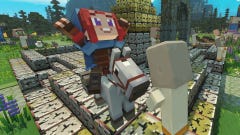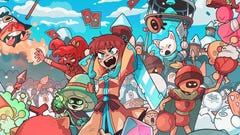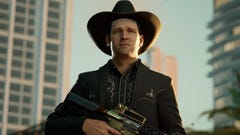Company Of Heroes 3 review: a glorious comeback for this WW2 RTS
Tank goodness
After the mud and forests of Normandy, and the grim, snowy climes of the Eastern Front, Company Of Heroes 3 feels like World War II on its summer holiday. With two campaigns spanning each side of the sunny Mediterranean, this is arguably Relic's breeziest and most colourful theatre of war yet, evoking the same kind of swagger and gung ho optimism as a Hollywood action flick. It's a feeling that might seem out of place given the current climate, especially now, just days away from the first anniversary of Russia's invasion of Ukraine. But while your main objective is always one of domination, gradually turning the map from red to blue on both a micro and macro scale, this is ultimately a game about searing comebacks - of beating back seemingly impossible aggressors, and finding hope where previously there was only despair. I think we could all do with a bit of that in this day and age, even if the battles before you end up feeling like nothing more than the digital equivalent of plonking down a big box of toy soldiers on your living room floor and going daka-daka-daka as they all fall over.
That's not to say Company Of Heroes 3 is a one-sided power fantasy, of course. While it may not dwell much on the lingering horrors of war, this is a real-time strategy game that thrives on building and maintaining the confident forward march of its respective victors. It remains brilliantly well-paced, and its backbone of building up your forces, positioning them into clever spots of cover, capturing territory and countering enemy advances with its wide array of upgradeable units is as strong as ever. Let up the pressure even for a moment and your supply points will be wrestled back from under your nose, resulting in the same tense and thrilling scraps that Company Of Heroes made its name on.
Or at least that's true of its many, many real-time mission maps. Whereas previous games presented you with a traditional set of real-time strategy battles one after another, the first and largest of Company Of Heroes 3's single player operations does things a little bit differently, giving you free rein to tromp through the whole of Italy's southern calf with its large, open-ended Total War-style campaign map. Starting in Salerno on the Amalfi coastline and stretching all the way up to Rome's imposing colosseum, this turn-based grand strategy layer lets you pick and choose your battles in whatever order you see fit, offering up a compelling mix of small skirmish battles and larger, more bespoke real-time mission maps as you go about capturing supply points and wiping out German defences with air, sea and land attacks.
You could quite easily make a beeline for Rome and call it a day here, but a smattering of secondary objectives will begin to pull you in all sorts of different directions, whether that's meeting up with fellow Allied forces at Bari on the Adriatic coast, or seeking out Italian resistance fighters in need of a helping hand. Pursuing certain actions will help garner favour with your equally combative US and UK general figures (as well as the leader of the Italian partisan forces), and securing their support through the choices you make on the campaign map will have lasting consequences for how you'll eventually approach your final push toward the Italian capital.



These secondary objectives feel wonderfully organic, too. Some are clearly designed to trigger when you reach certain points on the map, but others emerge as a direct result of your own moment to moment actions (aka: stupidity), making your journey through the country feel just as responsive and uniquely your own as its real-time missions. For example, while the overworld's population cap prevents you from having tons of individual units legging it around the Italian countryside, you do eventually unlock the ability to place down stationary defences such as anti-air guns and Howitzer emplacements to help dismantle the German defences at a faster rate. After all, your troops only have a limited movement range and number of action points they can take per turn, so provided you've got enough ammunition, fuel and manpower at your disposal, these emplacements can be vital in getting you out of sticky situations - such as when I accidentally parachuted one of my lads into a surprise sea of German machine gun turrets, paratroopers and armoured vehicle units in an attempt to take back another airfield that had previously been veiled in a thick fog of war.
Taking a leaf out of the tutorial book is where I used my navy vessels to soften up certain city defences, I deployed one of my nearby emplacements to help thin the crowds a bit. In the process, however, I accidentally ended up setting fire to a nearby town marked as a supply point. I had two turns to put that fire out, otherwise the ammo bonus I would have gained from capturing it normally would have gone kaput. Which is brilliant! And exactly the kind of thing I'd have hoped to see from this grand strategy component.

What's more disappointing is that the constant push and pull you're enacting down on the ground in its real-time mission battles just isn't present on the wider campaign map. I was playing on the Standard difficulty during my review, but once I'd captured a town, it was pretty much as safe as could be. I felt very little need to construct further defences to hold the fort down while my troops went elsewhere, and it's a shame there wasn't more of a tussle over our constantly changing territories. This seems like a missed opportunity, especially when larger towns require you to break down their defences first before you can invade and capture them. But not once did the AI even try and retake a lost city during my playthrough, making their overall threat feel quite inert outside of the game's real-time missions.
I suspect part of this may be down to a gaggle of lingering technical hitches. I can deal with the occasional flickering texture or momentary zoom-scroll freeze after the enemy AI's taken their turn, but planes in particular were bafflingly utilised, with enemy units seemingly content to fly over my troops to do little more than say hello, rather than, say, bomb the living crap out of them. The planes themselves were quite difficult to parse at the best of times, a lack of icons or identifying features making it nigh on impossible to tell the difference between recon, bomber and supply planes without the aid of WWII history degree. But even if they were distinct units, they also did naff all each time they flew over, implying they'd either bugged out completely (as one of own my recon planes did, frozen forever above the skies of Calabria), or that the AI's aggression levels simply aren't tuned quite right. In some ways, it's a relief to have a slightly easier ride on the campaign map, if only because its real-time battles are often hard-won and the peak of each victory troughs quite nicely with its more sedate overworld map, but a smidge more tension wouldn't have gone amiss either.


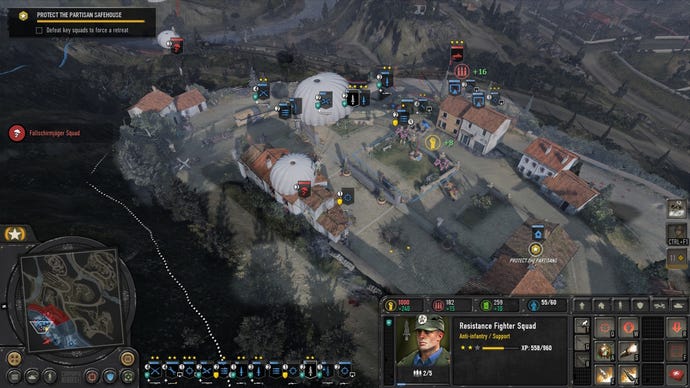

Still, the sheer breadth of what's on offer here in the Italian campaign is mightily impressive for a first attempt at this style of war gaming, and after ten years away since the release of Company Of Heroes 2, it feels like precisely the sort of homecoming you'd want from this prodigal RTS series. The constant flow of battles big and small will easily suck you in for 20+ hours if you want to conquer the entire width of the map, and I hope Relic get to iterate on this style of campaign further in the years to come. There's so much to dig into here, and the amount of strategic interplay between the map and its underlying missions is more than robust enough to support multiple playthroughs with wildly different tactical styles.
It feels like precisely the sort of homecoming you'd want from this prodigal RTS series.
I was also impressed by the lack of repetition in its plentiful supply of skirmish maps. Despite a healthy number of larger mission maps, skirmishes probably make up the bulk of the fighting you do in Company Of Heroes 3's Italian campaign. But only on a couple of occasions did I spot the same battlegrounds popping up again, but whereas the first time I had to capture and hold all three points around an enemy's base, for example, the second time I had to defend two strongholds of my own until back-up arrived. These differing objectives did a great job of recontextualising these couple of repeated maps, and it went a long way to make them feel new and exciting again. The rest of them, however, all seemed completely unique, which really isn't bad considering how many you'll end up fighting on.

If it's real nail-biting tension you're after, the shorter North African campaign is classic Company Of Heroes through and through - an entirely linear run of missions one after the other that see you skim across the sandy, northern edges of Libya and Egypt, culminating in the first battle of El Alamein in 1942. This isn't as long as what you might deem a traditional Company Of Heroes campaign - I polished it off in a very agreeable six hours over the course of a single day - but like the main Italian campaign, this is an enthralling rollercoaster of large, sprawling advances and smaller timed missions that continually take your breath away just as soon as you've caught it again.
Perhaps controversially, you're not playing as the Allied Forces here, but rather the Deutsche Afrika Korps, led by the ruthless field marshal Erwin Rommel. He's the bloke that earned the nickname Desert Fox at the time, and the DAK as a whole play quite differently to the US and British Gurkha troops you'll be switching between over in the Italian campaign - if only due to their heavier reliance on tanks and armoured vehicles to both control the battlefield and provide cover for your units trailing behind in its wide-open map spaces. This opens up even more strategic avenues to explore, and the maps make good use of the DAK's unique abilities. Shout out in particular to the brilliant recovery truck, who can patch up destroyed tanks after they've taken one too many shots in their flimsier side armour and add them back into your arsenal. Love you big time, recovery truck.


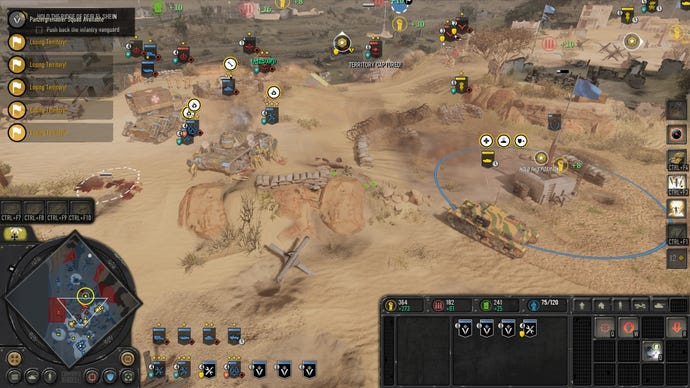
Of course, this company as a whole is hardly the band of 'heroes' this series normally celebrates, but Relic provide an effective counter to this tale of aggression by presenting it alongside two other stories from the opposite side of the trench lines. These follow a Jewish Berber man fighting alongside the Brits, and the effect the war has on his wife and daughter back home in Benghazi, their plights rendered in lightly animated cutscenes between missions. It's artfully done, and as later missions gradually turn toward retreating or simply holding the line while the cutscenes recount the eventual British comeback, it all does a surprisingly good job of reining in the zeal and excitement of earlier victories. That said, the final and climactic battle of El Alamein is really quite something, and arguably one of the most taut and expertly-paced missions in either of its campaigns. It's a real stand-out, even if you are playing as right old turds in the thick of it.
And outside of its two campaigns, Company Of Heroes' usual barrage of multiplayer options are all present and correct as well, including up to 4v4 co-op vs the AI, and up to 4v4 online against other players, which I'll be testing out in due course once its public servers go live. In short, there's a veritable boatload to sink your teeth into here, and even if you never end up touching the multiplayer at all, Company Of Heroes 3's sizable single-player campaigns are worth the price of admission alone - and that's including the technical issues I saw while playing for review, too.
At its core, Company Of Heroes 3 is a rip-roaring return to form and then some for Relic's much loved RTS, and its stirring orchestral score will have you beating your chest and yelling hoo-rah like only the best toy soldier fantasies can. If Relic can iron out some of those lingering campaign niggles, this could easily be an all-timer for WWII strategy buffs, especially once its multiplayer kicks off in earnest in the coming days. It might be the kind of beach holiday that's riddled with mortar shells, machinegun fire and tank explosions, but whichever road you end up taking, this is one trip that's definitely going to be for the history books.










